Biology
If you know anything about this blog, you know that we look for exceptions in every rule, so I wouldn?t tell you that there are definitive ways to tell venomous from non-venomous snakes. There are just too many exceptions; any mistake in this area could be your last.
We can use the black mamba and inland taipan snake examples for debunking the pupil myth as well. The mambas and the fierce snake are round, as are the pupils of the coral snake (very dangerous). More to the point, who wants to get close enough to a snake?s pupils to see if they are slit shaped or round? Let?s err on the side of caution; if you see a snake in the wild ? assume it?s venomous. Problem solved.
What is more, it would seem that the tooth that developed into a fang became linked to the development of the venom gland rather than the other teeth, suggesting that they co-evolved in all types of venomous snakes, linking the type of venom with the type of delivery and type of fang. Perhaps they all started out the same, but they developed their own combinations independently.
Great diversity in venoms and fangs aside, there are exceptions in venomous snakes. Let?s talk about the keelback snakes. They may be venomous, but they are also poisonous.
Debra Hutchinson published on the keelback snakes in 2007. Tiger keelback snakes (Rhabdophis tigranus) live in Asia, and enjoy a diet of cane toads ? poisonous cane toads! Cane toads kill most things that try to eat them, but for some reason the keelback snakes don?t seem to be bothered by the toxin.
In a 2005 study of spitting cobras, the red and black-necked spitters recognized faces and eyes, but would not spit at photographs of faces. That?s mighty evolved; you don?t want to waste the toxin, and you must be accurate to avoid waste as well. The black-necked was able to hit the eyes 80% of the time, and the red spitter never missed.
Vonk, F., Admiraal, J., Jackson, K., Reshef, R., de Bakker, M., Vanderschoot, K., van den Berge, I., van Atten, M., Burgerhout, E., Beck, A., Mirtschin, P., Kochva, E., Witte, F., Fry, B., Woods, A., & Richardson, M. (2008). Evolutionary origin and development of snake fangs Nature, 454 (7204), 630-633 DOI: 10.1038/nature07178
Mori, A., Burghardt, G., Savitzky, A., Roberts, K., Hutchinson, D., & Goris, R. (2011). Nuchal glands: a novel defensive system in snakes Chemoecology, 22 (3), 187-198 DOI: 10.1007/s00049-011-0086-2
Hutchinson, D., Mori, A., Savitzky, A., Burghardt, G., Wu, X., Meinwald, J., & Schroeder, F. (2007). From the Cover: Dietary sequestration of defensive steroids in nuchal glands of the Asian snake Rhabdophis tigrinus Proceedings of the National Academy of Sciences, 104 (7), 2265-2270 DOI: 10.1073/pnas.0610785104
- The Most: Related To Animals -4 (reptiles)
Anaconda 1. Fastest snake African mumba (30 km/hr) 2. Heaviest snake Anaconda (8.25 m length; 227 kg) 3. ...
- Amazing Facts About Reptiles
1. Boas, as well as many other snakes have special heat-sensitive organs that are called pits. These pits are on their heads. They can detect the heat given by a warm-blooded animal standing close to them. 2. ...
- It?s An All Or None Proposition
Biology concepts ? toxin, venom, cnidarians, kleptocnidae In our discussions of venoms and toxins we have looked at many groups (phylums) of animals. In each phylum we have identified at least one venomous animal. We have talked venomous amphibians (frogs,...
- A Salamander Superhero?
Biology Concepts ? primary and secondary toxin, passive and active defense, venom, poison, toxin salamander, newt Wolverine is a comic book character, as well as a recurring movie character played by Hugh Jackman. It?s hard to believe that this is the...
- One Man?s Poison Is Another Man?s Cure
Biology concepts ? toxin, poison, venom, LD50, ED50, therapeutic index The skull and crossbones is the most recognized symbol for poison. It originated at the entrances of Spanish cemeteries, so it has always been associated with death. With advent of...
Biology
Sneaky Snakes: Biters, Boobytraps, and Spit
Biology concepts ? venom, toxin, poison, fangs, evolution, toxicofera hypothesis
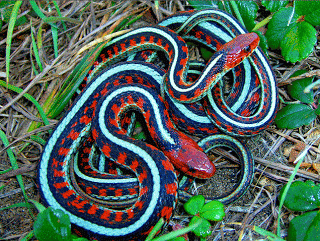 |
The California Red Sided Garter Snake is one beautiful reptile. It has round pupils, so it might be non-venomous, but it has a highly patterned and bright colored body, so it could be poisonous. It has a triangular head, but not to broad, so it could be either. For many years we thought it was non-venomous, but recent work says it has toxic saliva. It?s probably not too harmful to humans, but it goes to show that you can?t make assumptions. |
However, many people will tell you that the eyes of a snake will give them away ?round pupils means non-venomous, while slit pupils (like cats) means venomous. Or that venomous snakes have patterned bodies while non-venomous snakes wear solid colors. Lastly, some people will tell you that venomous snakes have triangular heads, while non-venomous snakes have rounder heads.
Let?s tear down each myth. About 99% of snakes have triangular heads. So this is no help at all; although, if you stay away from all triangular headed snakes you probably won?t get in trouble. Venomous snakes do have a broader base to their triangular head, to account for the venom gland volume and associated muscles. However, are you going to take the time to determine just HOW BROAD is the head of the snake that?s about to bite you?
As for pattern versus solid color; this will also fail you. Ever hear of a black mamba (Dendroaspis polylepis)? Well, it?s the most venomous snake in Africa and it?s solid colored. Strangely enough, the black mamba isn?t black. Its name comes from the color of the inside of its mouth, but its body is silvery. The Inland Taipan viper (Fierce Snake, Oxyuranus microlepidotus) is the most venomous on land, but it has a solid dark tan body.
Maybe pupil shape matters. I am wondering why there would be an evolutionary link between the shape of the pupil and whether a snake has venom. Head shape ? maybe, you have to account for venom glands. Body color ? maybe, patterns would warn a predator to stay away (aposematism). But pupil shape? How would that be linked to venom or no venom?
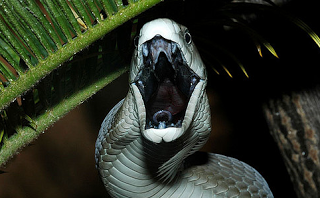 |
The black mamba is one of the most aggressive of venomous snakes. It?s as if it goes out looking for things to bite. And they are fast, moving up to 20 ft./sec (that?s 14 mph, or 22.5 kph), although I think Kobe Bryant can still move faster than that in short spurts. The mamba grows to over 10 ft in length and will attack a lion, so it backs up the deadly look of its open mouth ? it ain?t just for show. |
So let?s find some real exceptions in the realm of venomous snakes. Unfortunately, there are so many different combinations of fang type, venom type, and venom gland type that it is difficult to call any kind of venomous snake an exception ? there aren?t many rules. There are true venom glands and false glands, based on whether they can store venom. Then there are rear fangs, front fangs, and front fangs that can fold up. And then there are systems that deliver venom to several upper teeth, and those that deliver venom only through the channels in front fangs or rear fangs.
There may be different ways to deliver and different venoms to deliver, but a 2008 study says it all venomous snakes derive from a common ancestor that lived about 60 million years ago. The study of Dr. Vonk looked at front and rear-fanged venomous snake embryos, and saw that the venom gland ducts ALWAYS start out attached to a rear tooth, but in the front-fanged snakes, the tooth and duct move forward during fetal development!
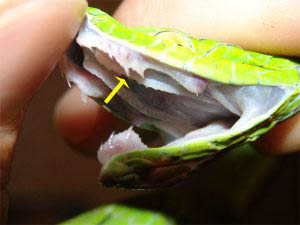 |
The rear-fanged snakes have back teeth that deliver venom, but not by injecting it like a hypodermic. They are not hollow; some have grooves for the venom to run down, while others are just sharp, bigger teeth. Snakes with rear fangs have to take a bigger bite, and hold on longer to grind the venom into the wound. Doesn?t sound like the perfect system, but evolution is striving for perfection, it just uses what is there. |
It may be that this occurred with all snakes; those that aren?t venomous just lost the ability to produce or deliver venom. This is part of the toxicofera hypothesis of which we have spoken. We don?t even know what percentage of snakes are venomous. Scientists have focused on the highly venomous snakes for so long, that the so-called non-venomous snakes have been ignored.
Many snakes that were once thought to be non-venomous are now known to have venomous bites. Colubridaesnakes (garter snakes, hognose snakes and many more) were thought up to the 1950?s to be utterly non-venomous. But Dr. Fry showed that many of these snakes do indeed deliver venom, though most may be harmless to humans.
As recently as ten years ago it was said that only 10% of snakes were venomous; now that percentage is somewhere near 30%. Where might it end ? could most snakes be venomous?
Even though scientists now know more about the evolution of venom, there are still mysteries. With millions of years to perfect a venom system, why is it that some snakes have venom that is WAY TOO POTENT for its purpose? With each bite the fierce snake delivers enough venom to kill 2000 mice or 50 humans ? why so much? It must be advantageous in some way; or else it doesn?t cost any more energy to make the venom that potent.
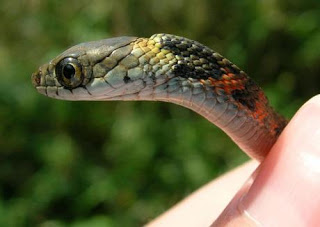 |
This is a juvenile tiger keelback snake. The raised part on the back explains the name. It is actually the nuchal gland that stores cane toad toxin as a defense. How could a small juvenile have toxin before it is big enough to start eating cane toads? It can be passed on from mother to offspring, if she ate a cane toad before egg format |
Debra Hutchinson published on the keelback snakes in 2007. Tiger keelback snakes (Rhabdophis tigranus) live in Asia, and enjoy a diet of cane toads ? poisonous cane toads! Cane toads kill most things that try to eat them, but for some reason the keelback snakes don?t seem to be bothered by the toxin.
In fact, they sequester the cane toad toxin to two nuchal glands, located on the back of their necks. Then, when the snake is threatened by a predator, they turn their back to the aggressor and dare them to bite down on the nuchal glands! Most predators have learned not to take the bait.
The nuchal glands are purely for storage. They don?t have ducts or deliver the poison to the skin or a fang. The sequestered toxin is purely defensive. But the keelbacks also have venom glands, of the false gland type, delivered to the base of several upper teeth. The keelback then bites, chews and grinds the venom into the wound.
This is the way it goes for many rear fanged snakes. Delivering venom by the front fangs is 100x more efficient than the rear fangs, so rear fang snakes must hang on longer to their target in order to envenomate them. This means that they are more vulnerable to being bitten when the target fights back. The keelback has made this less likely by storing another toxin in its neck. Pretty smart, huh?
Now for one more venomous snake exception. Your parents always told you not to spit, but a few snakes are expectorating geniuses. The spitting cobras (genus Naja, and a couple others) have an additional modification to their front fangs that gives them the ability to spit their venom, in some cases, over twenty feet.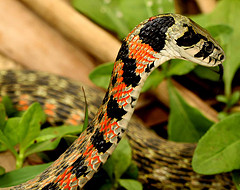 |
When threatened, the tiger keelback assumes a familiar neck arch position. This was described in Akira Mori?s 2012 paper. If disturbed, it will also try to bump the nuchal glands into the aggressor, They will spray toxic contents if bitten or pinched. |
Injecting venom from front fangs is controlled by specific muscles around the venom gland. Spitting snakes combine this quick delivery under pressure with a targeting system. Instead delivering venom from the tips of their fangs, they have an aperture (hole) in the front face of their fang (see picture). Some cobras aim for the eyes of their targets, while others aim for mouth, nose or skin.
The aim is incredible in all, but it is even better in some species. I will use guns as a model. Most guns and cannons up to the time of the US Civil War were very inaccurate. By gouging curved grooves down the barrel, a spin was placed on the cannon ball, and the spin made it much more accurate. This ?rifling? was invented in the 1500?s, but didn?t become common until the 1800?s.
The same is seen in the African (not so often in the Asian) spitting cobras. The fang and aperture have rifling grooves that make them even more accurate. I would say that humans stole the idea from nature (like we so often do), but I don?t think we knew about spitting cobras when guns barrels started being rifled.
But how does spitting (really squirting, no saliva is involved) venom at an aggressor help, other than grossing them out? We know that venom must be injected below the skin in order to be effective, but a spitting cobra?s toxin can be cytotoxic (lots of inflammation and tissue destruction) to the skin, and can blind if it hits the eyes. The black-necked cobra and the red Mozambique cobra have been shown to aim only for eyes.
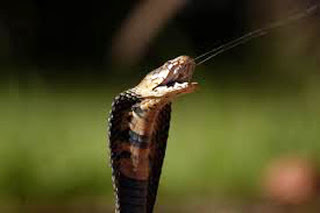 |
This is a Mozambique spitting cobra. Notice how the spray comes straight out from the front of the fangs and is directed in a narrow, pointed direction. This isn?t strafing fire, it?s sniper work. |
Most spitting cobras actually have a mix of toxins; some neurotoxic, some hemotoxic, some cardiotoxic, and some cytotoxic. Somewhere along the way, evolutionarily speaking, the spitting cobras concocted a toxin that has both the ability to harm by surface contact, and the ability to harm on contact. Evolution at its best.
Next week, is there a group of animals where every species is venomous? And how about a group where none of the species are venomous.
Vonk, F., Admiraal, J., Jackson, K., Reshef, R., de Bakker, M., Vanderschoot, K., van den Berge, I., van Atten, M., Burgerhout, E., Beck, A., Mirtschin, P., Kochva, E., Witte, F., Fry, B., Woods, A., & Richardson, M. (2008). Evolutionary origin and development of snake fangs Nature, 454 (7204), 630-633 DOI: 10.1038/nature07178
Mori, A., Burghardt, G., Savitzky, A., Roberts, K., Hutchinson, D., & Goris, R. (2011). Nuchal glands: a novel defensive system in snakes Chemoecology, 22 (3), 187-198 DOI: 10.1007/s00049-011-0086-2
Hutchinson, D., Mori, A., Savitzky, A., Burghardt, G., Wu, X., Meinwald, J., & Schroeder, F. (2007). From the Cover: Dietary sequestration of defensive steroids in nuchal glands of the Asian snake Rhabdophis tigrinus Proceedings of the National Academy of Sciences, 104 (7), 2265-2270 DOI: 10.1073/pnas.0610785104
For more information and classroom activities, see:
Snakes ?
http://www.google.com/url?sa=t&rct=j&q=&esrc=s&source=web&cd=5&ved=0CFsQFjAE&url=http%3A%2F%2Fschool.discoveryeducation.com%2Fteachersguides%2Fpdf%2Flifescience%2Fds%2Fcorwin_snake_anti-venom.pdf&ei=RvRRUfemCo-84AOTs4GQBw&usg=AFQjCNGgY6vAa4IXOa5k93fVb6WAfQjbJA&bvm=bv.44342787,d.dmg
http://www.pointloma.edu/experience/academics/schools-departments/department-biology/biology-graduate-programs-master-degree-biology/teaching-resources-snake-activities
www.torontozoo.com/adoptapond/rattlesnake_cur/unit1.pdf
http://www.bioquest.org/icbl/icbl_details.php?product_id=398
http://pages.uoregon.edu/titus/herp_old/wines.htm
http://guampedia.com/lesson-plan-s-curves-and-snake/
http://www.thefreeresource.com/poisonous-snakes-fun-facts-information-and-resources
http://www.discoveryeducation.com/teachers/free-lesson-plans/snakes.cfm
http://www.biologycorner.com/video-worksheets/
http://www.thewildclassroom.com/home/index2.html
http://www.tes.co.uk/teaching-resource/Venomous-snakes-medical-aspects-1950-6225447/
keelback snakes and nuchal glands ?
http://www.qm.qld.gov.au/Find+out+about/Animals+of+Queensland/Reptiles/Snakes/Common+and+dangerous+species/Freshwater+Snake+Keelback+Snake
http://ohfortheloveofscience.com/2010/11/30/bufotoxin-tolerance-in-keelback-snakes-recent-adaptation-to-a-new-threat-or-preadaptation-from-an-ancient-foe/
http://www.indianetzone.com/4/keel_back.htm
http://blogs.discovermagazine.com/notrocketscience/2008/10/13/the-snake-that-eats-toads-to-steal-their-poison/#.UVH4e4Vf13I
http://www.thefeaturedcreature.com/2011/09/tiger-snakes-uh-oh.html
http://www.nytimes.com/2007/01/30/science/30observ.html?_r=0
http://www.snakesoftaiwan.com/Rhabdophis%20tigrinus%20formosanus/species_rhabdophis_tigrinus.htm
spitting cobras ?
http://www.snakesoftaiwan.com/Rhabdophis%20tigrinus%20formosanus/species_rhabdophis_tigrinus.htm
http://www.arkive.org/mozambique-spitting-cobra/naja-mossambica/video-00.html
http://www.pbs.org/wnet/nature/lessons/righteous-reptiles/lesson-activities/4683/
http://www.kidsbiology.com/animals-for-children.php?animal=Ringhals%20or%20Spitting%20Cobra
http://www.youtube.com/watch?v=_5dtpMj9Ehs
http://www.youtube.com/watch?v=pdjfWDVI8Cw
http://news.nationalgeographic.com/news/2007/12/071207-new-cobra.html
http://www.livescience.com/7646-cobras-spit-perfect-accuracy.html
http://blogs.discovermagazine.com/notrocketscience/2010/05/14/how-spitting-cobras-shoot-for-the-eyes/#.UVH6eoVf13I
http://www.ecologyasia.com/verts/snakes/equatorial_spitting_cobra.htm
http://www.sciencedaily.com/releases/2010/05/100514074909.htm
http://lifeinthefastlane.com/2010/05/the-venomous-art-of-spitting/
- The Most: Related To Animals -4 (reptiles)
Anaconda 1. Fastest snake African mumba (30 km/hr) 2. Heaviest snake Anaconda (8.25 m length; 227 kg) 3. ...
- Amazing Facts About Reptiles
1. Boas, as well as many other snakes have special heat-sensitive organs that are called pits. These pits are on their heads. They can detect the heat given by a warm-blooded animal standing close to them. 2. ...
- It?s An All Or None Proposition
Biology concepts ? toxin, venom, cnidarians, kleptocnidae In our discussions of venoms and toxins we have looked at many groups (phylums) of animals. In each phylum we have identified at least one venomous animal. We have talked venomous amphibians (frogs,...
- A Salamander Superhero?
Biology Concepts ? primary and secondary toxin, passive and active defense, venom, poison, toxin salamander, newt Wolverine is a comic book character, as well as a recurring movie character played by Hugh Jackman. It?s hard to believe that this is the...
- One Man?s Poison Is Another Man?s Cure
Biology concepts ? toxin, poison, venom, LD50, ED50, therapeutic index The skull and crossbones is the most recognized symbol for poison. It originated at the entrances of Spanish cemeteries, so it has always been associated with death. With advent of...
